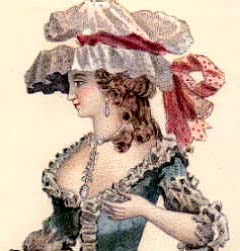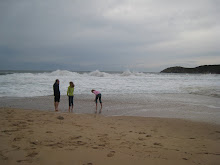 The photograph is taken from the driver's seat, looking out the windshield. The towers of Chartres Cathedral dominate the skyline; the car is on a cobblestoned street lined with all the standard shops of a French town. Bins of peaches and tomatoes line the sidewalk in front of the greengrocer's. Across the street, the window of the patisserie is filled with charlottes and éclairs and millefeuilles.
The photograph is taken from the driver's seat, looking out the windshield. The towers of Chartres Cathedral dominate the skyline; the car is on a cobblestoned street lined with all the standard shops of a French town. Bins of peaches and tomatoes line the sidewalk in front of the greengrocer's. Across the street, the window of the patisserie is filled with charlottes and éclairs and millefeuilles.A stoplight is on the upcoming corner; the light is yellow. A diamond-shaped sign sporting a yellow diamond is fixed to the post under the stoplight. As you take all of this in, a voice says:
My route has priority. Yes (A) or no (B)?
and
I stop at the light. (C)
I accelerate and pass through the light. (D)
A, B, C, D. Never mind about Chartres: you have 30 seconds to choose the correct response.
That's how the driving theory test works. There's a photograph of a driving situation and then a question related to some aspect of the photograph. Sometimes it's the meaning of a sign. Sometimes it's about the speed limit. Sometimes it's about how much your tires should be inflated (actually, there seem to be a lot of questions about tire inflation); sometimes, about legal alcohol limits. Sometimes the questions are answerable by yes or no, as in: Must the driver wear a seat belt at all times? More often, the questions are like the one above, and require you to assess the situation in different ways. Or to know--or be able to deduce--a range of information from the photograph. But always, always, the photos are taken in a discernibly French setting, whether it's in a Norman village of whitewashed houses or outside the gates of a château, on a boulevard in Paris or in the French Alps.
When I go to the School of French Driving (slogan: Together, let's live the road!), Madame le secrétaire nods from behind her computer. I pick up a vinyl-covered clipboard from the corner of her desk, take a blank test form from the top of the ream, and sit in the front row of the classroom. Assorted teenagers trickle in and take up their places at the back of the room. The driving school fly--I think he's on a retainer--buzzes around.
Madame le secrétaire comes in after a few minutes, on the hour or after, and puts a disc into the dvd player. And then the images begin to come up, 40 of them in all, and the teenagers and I sit there and circle our answers. I take notes, too: I write down on my paper questions that I get wrong so that I can check them later. At the end of the test, the teenagers loudly wad up their papers and toss them into the red plastic poubelle. I fold my test paper, put it away in my purse, and follow them out of the room. Madame asks each of us our score, and enters it in her computer. Once we regularly score above 35, we hear that we'll be deemed ready for the actual test and sent off to the préfecture to take it.
When I began taking the practice tests, I noticed the churches and castles and avenues of plane trees. Now all of those things fall away. The charm departs and I am in a plastic-lined Citroen wondering if my tires are adequately inflated and if the carbon emission level of my car is listed on its registration.
I wonder, too, if this isn't how cultural assimilation happens, when Chartres becomes the backdrop instead of the goal, and when the small shops with their careful displays are just the unspooling green screen to daily life. When what you notice is no longer the sites and sights but whether you can turn left here, or need to wait for the next intersection. When it's Tuesday afternoon, and Chartres is lovely, but you have to answer the question about the stoplight. It becomes a question of reconciling the France of Chartres and all that that is shorthand for--history, culture, beauty--and the France of small shops--gorgeous food, community, tradition--with the France of cracked plastic chairs and cigarette butts. That, as much as anything else, is the challenge for us at the School of French Driving.
That, and remembering the formula for calculating braking distance.





































